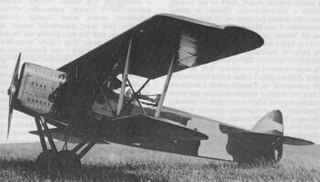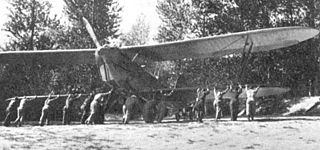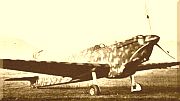| SPAD S.39 | |
|---|---|
 | |
| Role | Reconnaissance aircraft |
| National origin | France |
| Manufacturer | SPAD |
| First flight | 1 June 1921 |
| Number built | 2 |
The Bleriot-SPAD S.39 was a French carrier-borne reconnaissance aircraft built in the early 1920s.
| SPAD S.39 | |
|---|---|
 | |
| Role | Reconnaissance aircraft |
| National origin | France |
| Manufacturer | SPAD |
| First flight | 1 June 1921 |
| Number built | 2 |
The Bleriot-SPAD S.39 was a French carrier-borne reconnaissance aircraft built in the early 1920s.
The S.39 was a biplane with monocoque fuselage and wood and canvas wings. The undercarriage featured a hydroplane / flotation device.

Data from [1]
General characteristics

Hispano-Suiza was a Spanish automotive/engineering company and, after World War II, a French aviation engine and components manufacturer. It is best known for its pre-World War II luxury cars and aviation engines. In 1923, its French subsidiary became a semi-autonomous partnership with the Spanish parent company. In 1946, the Spanish parent company sold all its Spanish automotive assets to Enasa. In 1968, the French arm was taken over by the aerospace company Snecma, now a part of the French Safran Group.
Performance

Related lists

The Aero A.11 was a biplane light bomber and reconnaissance aircraft built in Czechoslovakia between the First and Second World Wars. It formed the basis for a large number of other Czechoslovakian military aircraft of the inter-war period. Around 250 were built, with some remaining in service at the outbreak of World War II.

The Aero A.101 was a biplane light bomber and reconnaissance aircraft built in Czechoslovakia during the 1930s.

The Blériot-SPAD S.34 was a French twin-seat, single-engine biplane flight training aircraft designed in 1920. The side-by-side seating arrangement was unique for its time. 150 aircraft were built, 125 for the French Air Force, who used them until 1936.

The Fiat CR.25 was an Italian twin-engine reconnaissance-bomber fighter aircraft which served in small numbers for the Regia Aeronautica during World War II.

The Bleriot-SPAD S.51 was a French fighter aircraft developed in 1924 in response to a French Air Force requirement for an aircraft to replace their obsolete Nieuport-Delage NiD.29s.
The Blériot-SPAD S.81 was a French fighter aircraft developed in 1923 to a requirement by the French Air Force. It was flown competitively against the Dewoitine D.1 and was selected over that aircraft due to the Dewoitine's more radical design, leading to an order for 80 aircraft. The S.81 was a single-bay biplane of conventional configuration with I-shaped interplane struts and lacking Herbemont's usual swept upper wing. It featured a wooden fuselage of monocoque construction and metal wings skinned in fabric. Production versions differed from the prototypes in having a lengthened fuselage and larger tail fin.

The SPAD S.XI or SPAD 11 was a French two-seat biplane reconnaissance aircraft of the First World War. The SPAD 11 was the work of Louis Béchereau, chief designer of the Société Pour L'Aviation et ses Dérivés (SPAD), who also designed the highly successful SPAD 7 and SPAD 13 single-seat fighter aircraft. It was developed under military specification C2, which called for a two-seat fighter aircraft. As a result of its failure to meet the levels of performance and agility demanded by the C2 specification, the SPAD 11 was used, along with the more successful Salmson 2 and Breguet 14, to replace aging Sopwith 1½ Strutter and Dorand AR reconnaissance aircraft. Persistent problems with the SPAD 11 led to its early replacement by the SPAD S.XVI or SPAD 16 variant.
The Hanriot HD.7 was a French fighter prototype of the 1910s.
The SPAD XIV was a French biplane floatplane fighter aircraft built by Société Pour L'Aviation et ses Dérivés (SPAD) and flown by the French Navy during World War I.

The Caproni Ca.335 Maestrale (Mistral) was an Italian single-engined two-seat fighter-bomber/reconnaissance aircraft of the 1930s.
The Blériot-SPAD S.29 was a sport aircraft produced in 1919 by Blériot-SPAD.
The Early Bird Spad 13 is an American homebuilt aircraft that was designed and produced by the Early Bird Aircraft Company of Erie, Colorado. When it was available the aircraft was supplied as a kit and also in the form of plans for amateur construction.
The SPAD S.XV was a single-seat fighter designed and built in France and offered to fulfil a 1918 C1 specification.
The Breguet 610 was a reconnaissance seaplane built in 1934 by the Breguet company.
The Bleriot-SPAD S.26 was a seaplace racer aircraft built in the late 1910s.
The Bleriot-SPAD S.30 was a French sports aircraft built in the early 1920s.
The Blériot-SPAD S.41 was a French fighter aircraft developed in the early 1920s.

The SPAD S.42 was a French biplane trainer aircraft of the early 1920s, developed by Société Pour L'Aviation et ses Dérivés (SPAD) from prolific SPAD S.XIII fighter.
The Bleriot-SPAD S.540 was a trainer monoplane aircraft built by SPAD in the early 1930s.
The Bleriot-SPAD S.36 was a French reconnaissance aircraft built in the early 1920s.
| Wikimedia Commons has media related to Blériot-SPAD S.39 . |